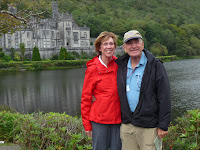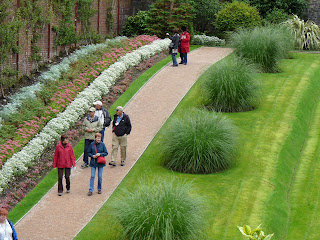Thursday, September
13 Galway/Optional Connemara &
Kylemore Abbey tour
After breakfast, the entire group journeyed through
Connemara region of Galway. Once home to
more than two-million Irish, it still retains its regional heritage, as we
ramble around its lakes, mountains, and bogs.
Bob & Mike in the Bog
A walk in the Bog
Diane and Phil
Our first stop was to walk on and look at a blog. Our guide told us that some bogs contained
2000 year-old bodies. They cut the bog
(which is not a renewable resource) and use it for burning/heating (peat). We passed by the Connemara Giant statue. Its inscription stated that “on this site
absolutely nothing happened”!
Connemara Giant Statue
Rose &Bob at Kylemore Abbey
Kylemore Abbey
Bob made me add this--
 Carolyn & Roy
Carolyn & Roy
Diane, Nancy, Rose, Carolyn in the back of the bus
We then visited the former Gothic mansion of Mitchell Henry,
now home of Benedictine nuns and better known as Kylemore Abbey. We wandered through the mansion and the
Victorian gardens. We could have spent
more time there.
We then cruised Killary Harbor, a fjord-like inlet. We had a great lunch while cruising. It was finished off with Irish Coffee or
Irish Cream coffee. It is nothing like
what we have in America. It is much
better!!
What we learned today:
Our guide calls his wife “the leader of the opposition”. If you live in Northern Ireland you call it
Northern Ireland. If you live in the Republic,
you call it North of Ireland. There are
10 million sheep and only 6.2 million people in Ireland. Flashers on a car/bus are called “park
anywhere flashers”. The Famine was
really a”great hunger” because there was food but the food was owned by the
Lords and they wouldn’t give it to the people.
There were 8.2 million people prior to 1945. During the famine, 1 million people died, 1
million people emigrated, and over the next 5 years, another 2 million people
emigrated. The Chaktau (sp?) indians helped
the starving Irish by donating money to help feed them.
On the return to Galway, we traveled through the Inagh
Valley to the coast seeing the deserted village of Clough Na Mara and discover
a sense of hardship the Irish experienced in the 18th and 19th centuries. Only shells of their homes remain.
Later, our bus driver John drove us to the city of Galway. The city spans both sides of the River
Corrib. In the center of Eyre Square
stands the Quincentennial Fountain, constructed in 1984 to mark the 500th
anniversary of the Royal Charter granted by King Richard III that created
Galway as an independent city-state. Nearby
are some of the oldest streets in Galway, narrow winding lanes that curve in
and around old wooden buildings, often meandering off toward the Corrib and the
docks. Turn the corner and there is
modern Galway. Artists and musicians
crowd the sidewalks and almost every pub seems to offer live music. We ate at the Busker Brownes. We had some fabulous food—and of course,
pints!!
Over the centuries, people have also made their mark, with
towers, quarries, and well-worn paths, but they're almost lost in the scale and
grandeur of the sea cliffs. One that
does stand out is O'Brien's Tower, a huge structure built to house the guests
of Cornelium O'Brien, Country Clare's legendary Member of Parliament from the
1830s until he died in 1857.
Friday, September
14 Galway/The Burren & Cliffs of
Moher/Killarney
After breakfast, we departed Galway for Killarney. On the way we discovered the intense natural
beauty of Eire to the Burren and the Cliffs of Moher. The Burren's name is derived from a Gaelic
word meaning "stony place" and it is like no other place in Ireland. Instead of peat bogs and pastures, there is a
surreal moonscape full of huge limestone crags.
Green of Ireland
A diverse array of plant life, including wild orchids and
rock rose, thrives here. Alpine plants
nestle in crevices beside temperate species.
The white, deeply crevassed limestone conceals
"micro-environments" rich in potholes and hollows. The ample rainfall and strange topography
have resulted in a paradoxical profusion of artic and semi-tropical vegetation growing
side by side. The roads are narrow and windy, and scary.
Moonscape in Ireland
The majestic Cliffs of Moher are precipitous rock
formations, towering nearly 700 feet above the crashing ocean surf at their
highest point, that offer breathtaking panoramic views of Ireland's Atlantic
coast. These magnificent cliffs provide
nesting sites for seabirds. The wind was
very strong today. You could hardly
walk, because a gust would blow you backwards.
It was mostly sunny, though, and the views were fantastic. The visitors center was really great, with a
virtual tour of the cliffs as seen by a bird.
Cliffs of Moher
Bob windswept on the Mohers
O'Brien's Tower
"Lovely" ladies at the Cliffs
Rose & Nancy
What we learned along the way: a half hour such as 9:30 is spoken as “half 9”. Children in Ireland are called “precious”,
such as we are taking our precious to school this morning. When the bus driver drives on the “cats eyes”
(which is the bumpy, separated line along the side of the road), they call it
driving through Ireland by Braille. To
make a stop or pull over, you call it a “tuck in”. Divorced is called “between phases”. If you “took the soup”, it means that you
switched religions in Ireland so you could eat soup during the Famine. So if someone “took the soup”, they switched
sides (to survive). Public Houses are
called “pubs” (makes sense).
Bus on the Shannon Ferry
We boarded a Shannon Ferry and we sailed across to Tarbert
in the county of Kerry, Republic of Ireland. Along the way we saw people playing golf on the windy courses.
Our guide, Denis is from this city, and we will spend the next three
nights in Killarney. The market town is
known for its verdant, rolling hills and glittering loughs (lakes). We are staying at the Killarney Towers. We took a short walk around the town with the
guide and then ate in the hotel. We had
rack of lamb and wonderful veggies and dessert to name just a few things
Playing golf on the lynx course
View above the town of Killarney






















We would have loved to have watched Jim eating that leg of lamb! That was quite an impressive hunk of meat!
ReplyDeleteHappy Birthday Rose!!
Thanks for providing explanation of what the phrase "took the soup" means, where it came from.
ReplyDeleteOnly one on the web believe it or not.